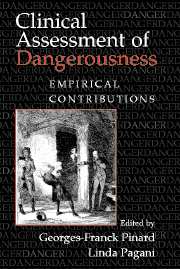Book contents
- Frontmatter
- Contents
- Contributors
- Prologue
- Introduction
- Basic Issues in Violence Research
- 2 Biology, Development, and Dangerousness
- 3 The Development of Physical Aggression During Childhood and the Prediction of Later Dangerousness
- 4 Predicting Adult Official and Self-Reported Violence
- Mental Health Issues and Dangerousness
- Family Issues and Dangerousness
- Individual Characteristics and Dangerousness
- Conclusion
- Index
4 - Predicting Adult Official and Self-Reported Violence
Published online by Cambridge University Press: 03 July 2009
- Frontmatter
- Contents
- Contributors
- Prologue
- Introduction
- Basic Issues in Violence Research
- 2 Biology, Development, and Dangerousness
- 3 The Development of Physical Aggression During Childhood and the Prediction of Later Dangerousness
- 4 Predicting Adult Official and Self-Reported Violence
- Mental Health Issues and Dangerousness
- Family Issues and Dangerousness
- Individual Characteristics and Dangerousness
- Conclusion
- Index
Summary
The main aim of this chapter is to investigate how far adult violence (after age 21) could be predicted in the Cambridge Study in Delinquent Development. The Cambridge Study is a prospective longitudinal survey of 411 South London males from age 8 to age 40. As explained later, previous analyses have focused on predicting youth violence (under age 21), violence at any age, or specific types of violence (e.g., spouse assault or soccer hooliganism). This chapter compares the prediction of convictions for violence in official records for offenses committed between ages 21 and 40 with the prediction of self-reported violence between ages 27 and 32.
This chapter investigates the efficiency of predictors of adult violence at different ages (10, 14, and 18). It distinguishes behavioral and explanatory predictors of adult violence. Childhood aggression is an example of a behavioral predictor, whereas harsh parental discipline is an example of an explanatory predictor. Childhood aggression probably leads to adult violence because of the persistence over time of an underlying construct such as aggressive personality. Harsh parental discipline may lead to adult violence because it has causal effects on an underlying construct such as an aggressive personality; perhaps children learn by observation that aggression is a legitimate way of solving interpersonal problems. Behavioral and explanatory predictors have different implications for intervention. Behavioral predictors identify people who should be targeted in intervention programs, whereas explanatory predictors identify not only people but also causal mechanisms to be targeted.
- Type
- Chapter
- Information
- Clinical Assessment of DangerousnessEmpirical Contributions, pp. 66 - 88Publisher: Cambridge University PressPrint publication year: 2000
- 21
- Cited by

